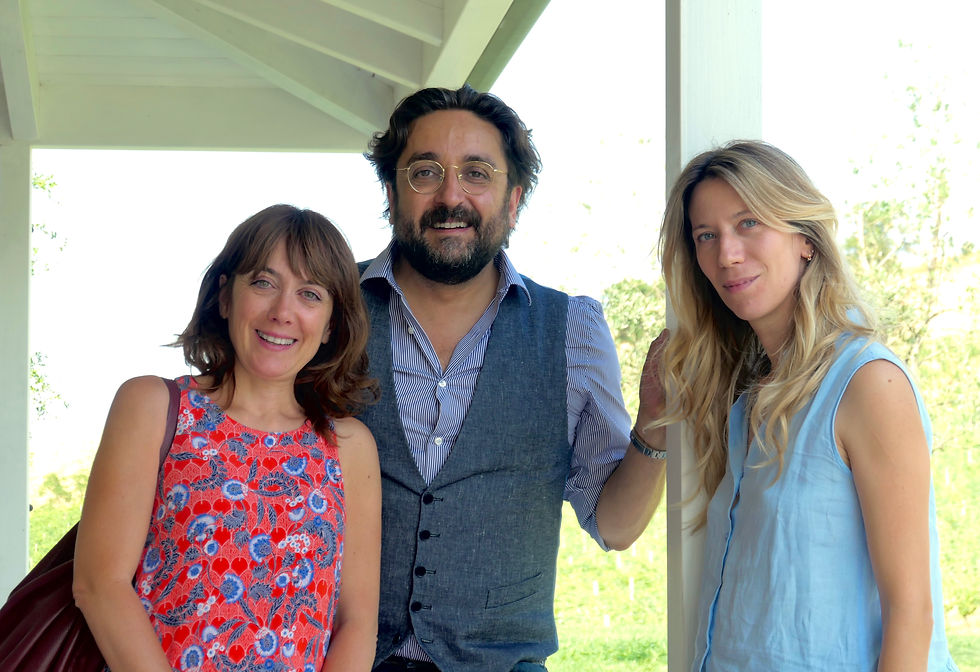
For our visit to Poggio della Dogana in the Romagna hills overlooking the historical town of Terra del Sole we traveled by way of the old road from Florence. It’s a long slow road full of hairpin bends that climbs through the National Park of the Casentino Forests, summits the 3,000 foot Muraglione Pass close to the Tuscan border with Emilia Romagna and then descends for 30 miles alongside the Montone river to Terra del Sole.

Like the road from Lucca to Modena over Abetone, this is another ancient route over the Apennines used today mostly by people vacationing up in the mountains to escape the torrid summer heat of central Italy.
A short hike from the high point on the Pass you’ll also find the impressive 250 foot high Acquacheta waterfall which Dante stumbled on during his wanderings while in exile from Florence; he describes the noise the waters make in the 16th Canto of the Inferno.
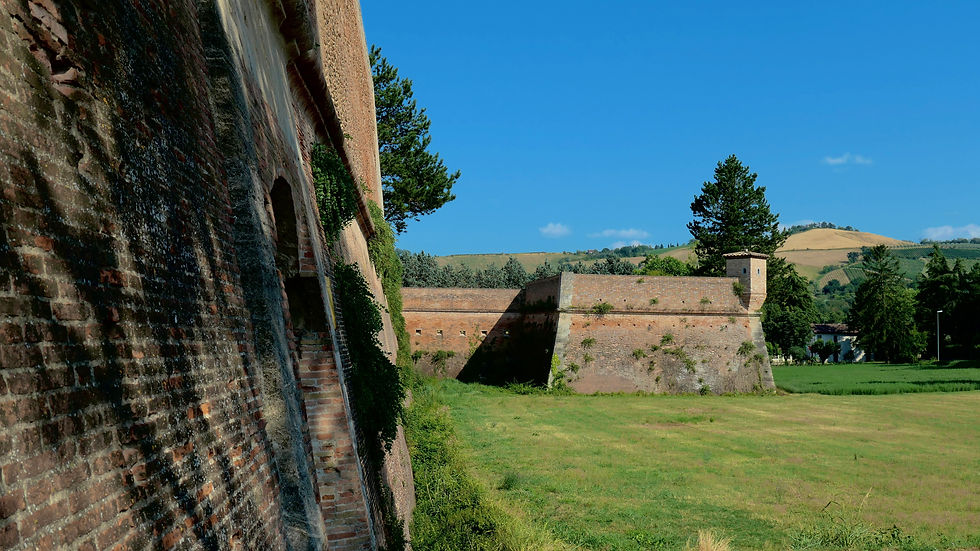
This is a route through the Apennines that's full of history and our destination, Torre del Sole, marks the farthest reach of Florence under Medici rule. Designed to be the ideal Renaissance town, construction began in 1564 and included 40 feet high defensive walls around the perimeter, built massively thick at the base, just like Lucca’s walls, in order to withstand the new siege cannons that had devastated so many earlier Renaissance defenses.
Terra del Sole’s purpose was to defend the border with the Papal States and this part of Romagna history was commemorated by the owners of Poggio della Dogana in their choice of the name, the literal translation being ‘Customs hill’. The commanding position of their vineyards on the slopes overlooking town marks the old customs border between Florence and the Papal States
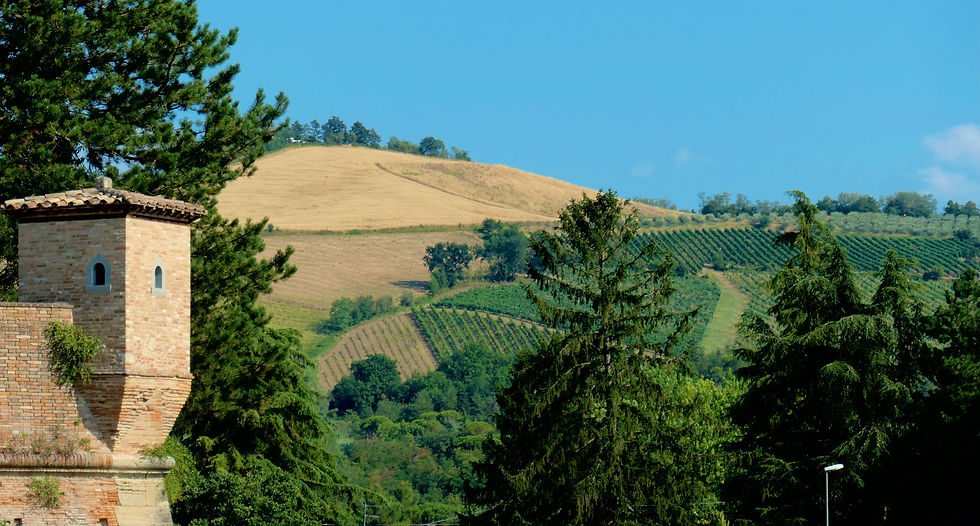
The first thing that struck us on our visit to Poggio della Dogana was how much these people love what they do and how emotionally invested they are in their project. We met with Aldo Rametta, one of the two brothers who are majority owners of the estate, Aldo’s wife Angela and the winery’s Commercial Director, Fabio Castellucci. Aldo is a well traveled individual internationally, who also worked in New York for several years. His passion for Poggio della Dogana is immediately apparent and it has as much to do with the fact that this family project is located in his native territory of Romagna as it has to do with his lifelong interest in wine.
And their vineyards are not simply physically located in Romagna, they also make traditional Romagnolo wines from indigenous Romagnolo grapes. Many people associate Sangiovese primarily with Tuscany but this grape has been documented in Romagna as far back as 1672 and Sangiovese Romagnolo is one of many different biotypes that are in use today. Ian D’Agata, in his scholarly book ‘Native Wine Grapes of Italy’, remarks that certain worthwhile Sangiovese clones “are of Emilia Romagna origin, which clashes a tad with those who uphold the superiority of Tuscan Sangioveto”.
After only 8 years in Italy I’m probably not yet qualified to comment too much on regional Italian differences in character and outlook but the second thing that struck me on this visit was the warmth and hospitality of the Romagnoli. Like Aldo, Fabio is also from Romagna and though Angela is a native of nearby Padova she also seems to have adopted this corner of Italy.
This visit was instructive for me culturally as it helped me understand that while Emilia Romagna is one Italian region it is made up of two distinct peoples and perhaps the Rimini artist Luigi Pasquini put it best when he remarked many years ago on the difference between the two parts of this region, as follows:

“È sul Sillaro, a Castel San Pietro che passa il confine fra la Romagna propriamente detta e il Bolognese. Una prova che la divisione esiste? Eccola: esci da Bologna lungo la via Emilia e vai dalla parte di Modena. Entra da un contadino e domandagli da bere. Ti dà un bicchier d'acqua. Esci da Bologna lungo la stessa via Emilia e vieni verso Imola. Entra da un contadino e fagli la stessa domanda. Ti dà un bicchier di vino. In Romagna il vino non si chiama vino. Si dice: e' bé, il bere”
Many of the wineries we write about have stories that take decades to unfold because you only get one harvest each year and changes happen slowly in the world of wine. At Poggio della Dogana they are only on their 5th harvest but they already have an impressive portfolio of 7 wines including several single vineyard or cru Sangiovese reds and, though winemakers are always tinkering and fine tuning things, the fundamental direction of the winery is set and they are justifiably happy with the results.
How did it all fall into place so quickly? Aldo and his brother, Paolo, got the two most important decisions right. The first was to recognize the potential of the vineyards they purchased five years ago and the second was to appoint Francesco Bordini as their agronomist and oenologist.

Francesco is the latest in many generations of the Bordini family to become an agronomist. His father, Remigio, is a legend in Romagna viticulture for his detailed understanding of the behavior of the Sangiovese grape in Romagna and who for decades meticulously documented the weather conditions of every harvest he experienced. In an interview given earlier this year Francesco paid tribute to his father as a man of the vineyard who hardly ever sets foot in the cellar. Francesco himself now has his own twenty years of experience as an agronomist, but with the added expertise of also being a renowned oenologist.
These days Francesco’s own notebooks are a record of not just the weather conditions for each vintage but also the climatic changes that have taken place over the last twenty years, changes that potentially threaten the continued suitability of lower elevation vineyards, not just in Romagna but also in Tuscany, as we wrote about in our article on Monte Bernardi.
Higher altitudes may soon become the only weapon winemakers have left to preserve the essential acidity and balance in Sangiovese wine and Francesco’s belief is that vineyards over 1,200 feet are once again the sweet spot in making wines of finesse and elegance.
Francesco says “once again” because it’s not only climate change that is rejuvenating higher elevation vineyards but also a return to traditional winemaking away from the highly extracted and overly concentrated wines that were fashionable for much of the 1990s and first decade of this century. This has also been a theme common to many of the winemakers we have visited and interviewed throughout this series of articles.

Francesco was also instrumental in the initial decision made by Aldo and Paolo to buy Poggio della Dogana five years ago. The vines then were only ten years old and the grapes were being sold to a Cantina Sociale to be mixed with other grapes in the wine making process so the opinion of their agronomist was key to recognizing that the location of the vineyards, their soil, aspect and elevation were perfect for Sangiovese and in fact individually good enough to permit single vineyard cru wines to be produced without the need for blending.
Poggio della Dogana consists of two distinct locations several miles apart, Terra del Sole (part of Castrocaro Terme) and Brisighella, both of which are at elevations of between 600 and 1,000 feet and which together produce 30,000 bottles each year.
The hills above Terra del Sole consist of 22 acres and this is the most important of the two for Sangiovese. The largest vineyard of 9 acres, directly above the tasting room (as you look at the top photo), produces I Quattro Bastioni grapes and also some of the Sangiovese for the metodo classico spumante called Vindice. The vineyard to the right is dedicated to the Poggiogirato Riserva and to the left is the third Sangiovese cru Santa Reparata. The remainder is planted with Trebbiano Romagnolo vines for the Nubivago white wine and Albana for the Belladama white wine.
The Terra del Sole vineyards are predominantly clay infused with calcium and minerals reflecting the fact that the town of Castrocaro itself has the suffix terme in its name courtesy of the mineral rich thermal baths discovered here centuries ago.
The Brisighella location consists of 27 acres of sandstone, limestone and clay soils and produces just one Sangiovese red wine called Arlesiana, with the rest of the acreage planted to grapes for blending with the Terra del Sole grapes in the production of the white wines Vindice, Nubivago and Belladama.

These are all the wines currently being produced, but a mere three years ago Aldo had only the Quattro Bastioni to take with him to his first wine symposium in Rimini in 2018 and then in 2019 he added a second Sangiovese and a white wine also. Arlesiana and Vindice are the two recent additions to the lineup so the current portfolio of 7 wines has been assembled over quite a short period of time, especially considering that there are no vinification premises or winemaking equipment on site.
With everything humming along nicely at Poggio della Dogana, an opportunity presented itself to Aldo and Paolo in 2020 that was too good to pass up. More accurately, the opportunity had a lot to do with Francesco Bordini’s father Remigio. For fifty years he was the agronomist at the storied estate of Castelluccio in nearby Modigliana and together with the oenologist Vittorio Fiore had made it the premier wine producer in Romagna. When it became available for sale Aldo and Paolo were immediately interested and they completed the purchase in July 2020.
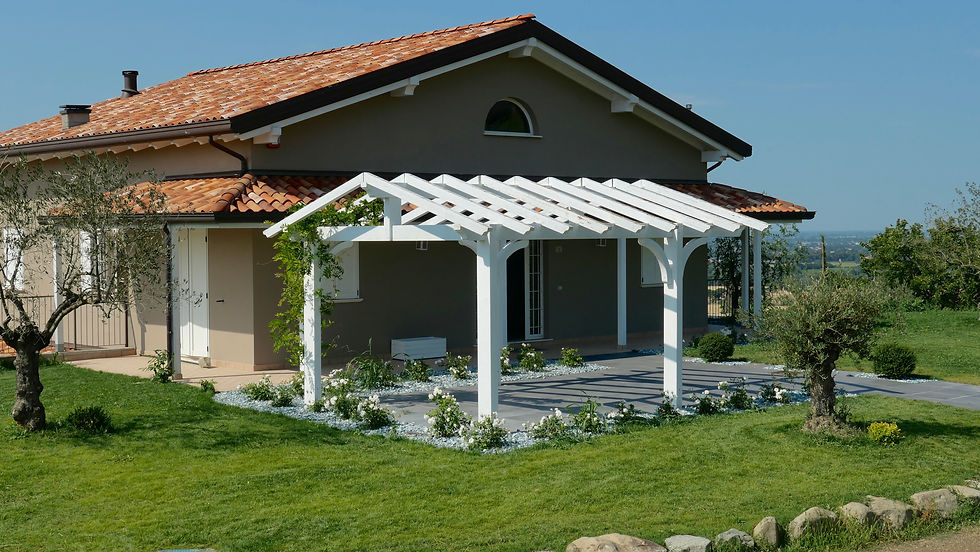
It solves one problem immediately in that now the Poggio della Dogana wines can be vinified in the Castelluccio cellar and in addition it provides an insurance policy against further climate change with these additional 30 acres in Modigliana being at an elevation of 1,600 feet. The pedigree of the Castelluccio vineyards is already proven however because its Sangiovese wines have for years found an appreciative audience among domestic and international customers.
The goal here for Aldo and Paolo is to revive all the single vineyard cru wines and allow the character of the individual vineyards to express themselves in the finished wine as they have already done at Poggio della Dogana. And it is very fitting that after all the decades personally invested in the Castelluccio vineyards by Remigio Bordini, the job of ensuring the continued health of the vineyards passes now from Remigio to his equally capable son Francesco.
The new combination of Poggio della Dogana and Castelluccio will consist of about 80 acres across three locations producing 100,000 bottles per annum.

Next to their vineyards the grain harvest was underway at the time of our visit and some of these fields are in fact part of the Poggio della Dogana estate. Romagna is famous for its piadina and much of the soft wheat flour that goes into this type of flatbread is made from locally grown wheat. Perhaps this is also where my loaf of sourdough bread starts because Molino Spadoni is a 100 year old Romagna producer of high quality flour that is based nearby and its macina a pietra tipo 1 flour is the one I use the most for bread making.
Tasting Notes:
All the wines are fermented and aged in stainless steel with the exception of the Arlesiana where a concrete tank now shares the aging with stainless steel, and the Poggiogirato riserva which spends 9 months in tonneaux and 6 months in stainless steel. Only partial malolactic conversion takes place for the two white wines and all of Poggio della Dogana’s wines are certified organic.
Most of the bottles have interesting labels and names and behind each one is a Rametta family story, many of them linked to notable horses from their maternal grandmother's stable. The label designs are from various Belle Epoque era drawings by their ancestor, Silvio Gordini, a famous Romagnolo artist.

Nubivago 2020 - Romagna Trebbiano DOC (12.5%)
Trebbiano Romagnolo 100%
Straw yellow with green reflections. Lots of white fruits and aromatic herbs on the nose, this is a very fresh wine with some pleasant salinity and the fruit follows through on the palate. There's nothing showy or overworked here. The acidity is good but not excessive and there's a slight sourness in the finish that keeps it refreshing. A well made very appealing summer white wine that is light but not thin.
(price not currently available)
Belladama 2020 - Romagna Albana Secco DOCG (13.5% alcohol)
Albana 100%
This is a grape variety with centuries of history in Terra del Sole so it's surprising perhaps that outside Emilia Romagna, Albana wines are little talked about. There are citrus and pear notes here and it's an easy drinking summer wine that has just a little bit more body and heft than the Nubivago. I've had other Albana wines that lacked freshness because this varietal can oxidise easily, but the Belladama is well made, vibrant and really refreshing. Very good value at 9.60 euros
Vindice Metodo Classico Pas Dosè (12.5% alcohol)
Sangiovese Romagnolo 100%
As soon as you pop the cork on this Champagne-method sparkling wine and fill your glass the aroma really jumps out; it's very fresh and quite powerful with notes of biscuit, yeast and golden delicious apples. A 100% Sangiovese grape spumante is a first for us and it's a very interesting wine. On the palate it's bright, crisp and acidic with a pronounced apple flavor that's much more of the tart granny smith type. We loved this wine at the tasting in Terra del Sole and now in Lucca, drinking this in a Tuscan heat wave, it's even better. Aldo says that this will probably sell for under 20 euros in Italy, which would make it excellent value as it's every bit as good as most non vintage Champagnes.
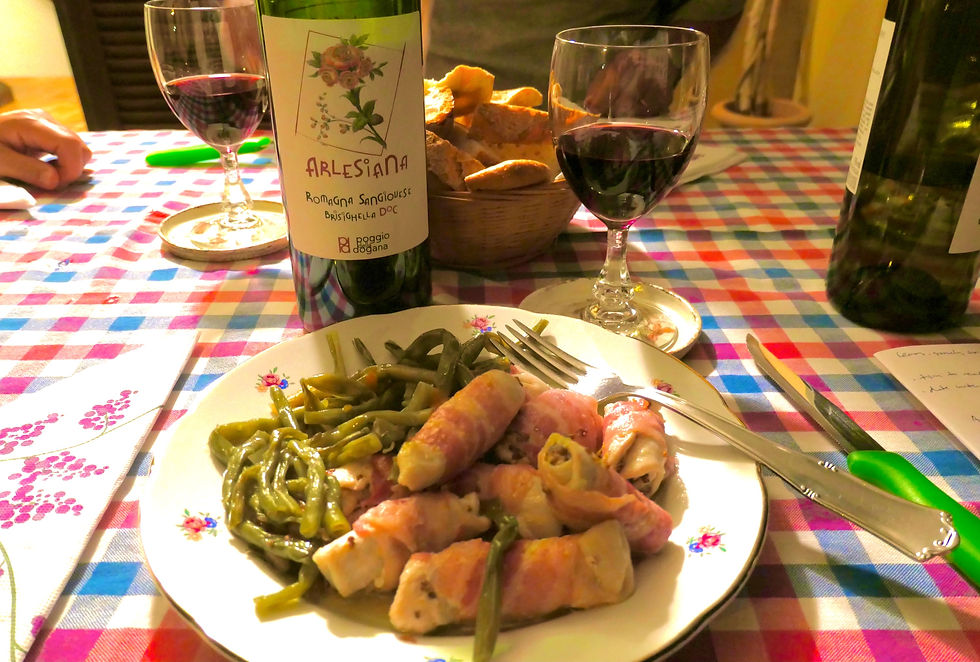
Arlesiana 2019 - Romagna Sangiovese Brisighella DOC (13.5% alcohol)
Sangiovese Romagnolo 95%, Ciliegiolo 5%
Full nose of cherries, more ripe than sour with well integrated tannins. Texturally in the mouth this is quite soft and velvety with real elegance but also some lovely juicy acidity. It needs food and there are hints of spice and liqueur in the wine that went very well with a strongly flavored plate of chicken and bacon involtini with fagiolini.
(price not currently available)
I Quattro Bastioni 2018 - Romagna Sangiovese Superiore DOC (13.5% alcohol)
Sangiovese Romagnolo 100%
Intense red becoming quite pale at the rim. Gorgeous full deep nose of mature red fruits, even a little candied. In the mouth it's round and rich, right in the sweet spot at 3 years old with everything in balance. I'm gobsmacked that this sells for 10 euros and I can't think of a better value red wine anywhere in the whole of Italy at this price. This is a high quality wine that's the equal of many much more expensive Chianti Classico wines. Fabulous wine. Clearly these very capable Romagnoli don't need any advice from Tuscans when it comes to the Sangiovese grape.
Santa Reparata 2017 - Romagna Sangiovese DOC (13.5% alcohol)
Sangiovese Romagnolo 100%
It may be a little unfair to compare this 2017 to the sensational 2018 above because of the different vintage conditions but though it's not quite as expansive and fruit forward there's a different dimension here that is equally attractive. Easy to like but harder to describe, there's a smokiness, even a slight reduction, here that gives it a much more velvety and even slightly sweet complexion. Lots of depth and unobtrusive tannins, we like this wine a lot because it has a very different and really quite beguiling profile compared to I Quattro Bastioni. This is a wine that keeps getting better in the glass. Another great value at 12 euros.
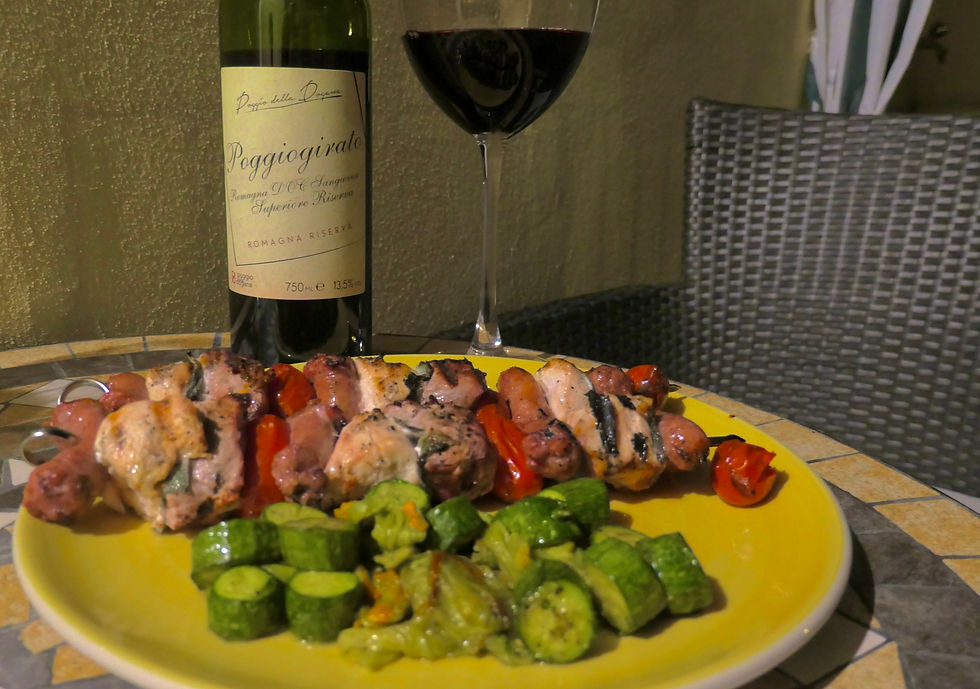
Poggiogirato 2017 - Romagna Sangiovese Superiore Riserva DOC (13.5% alcohol)
Sangiovese Romagnolo 100%
Very different label and actually a very different, less exuberant wine. Quite muted on the nose and less forthright on the palate than the previous wines but there are several layers to this, it just needs a little more time.
Second evening: after 24 hours with some aeration it really opened up. Thick and chewy with lots of mature red fruit and tannins that are perfectly in balance with food, it has a long finish and real depth. Pared very well with skewers of barbecued pork, chicken and sausage with sautéed zucchini. At 18 euros this is good value for a high quality riserva but the two previous wines are simply sensational value and in our opinion can't help but overshadow the price/quality relationship here.
